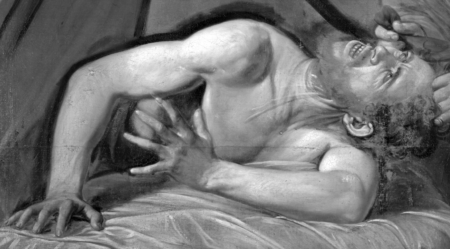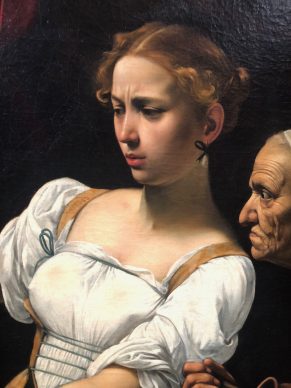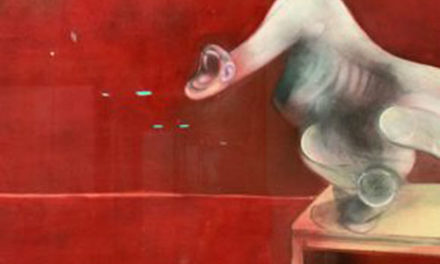Uncertainty for ever
In the field of Old Masters art uncertainty reigns. The most distinguished specialists spend their time contradicting each other and new discoveries from the history of art flourish in publications. For in the distant past, more often than not, paintings weren’t signed by their author, and works were made by various hands at famous studios run by artists who had a good head for business, or were signed by others, much later, in order to make a profit.
Biographical inaccuracies and the ravages of time, as well as clumsy restorations, also impact on the current reading of these paintings passed down through the centuries.
Magical names
Today, the field concerns a small albeit global circle of Old Masters enthusiasts, with the exception of a few “magical” names which appeal to everyone. In this category we won’t dwell on Leonardo da Vinci and his overly restored painting, the “Salvator Mundi” sold in November 2017 for 450 million dollars in all likelihood to the Saudi leader Mohammad Bin Salman, which today is nowhere to be found despite the promise of an exhibition last September at the Louvre Abu Dhabi (cf. the last report dedicated to the subject).
To a lesser extent we could also cite Rubens, Rembrandt, Vermeer or Caravaggio.
Behind a mattress
As it happens, in April 2014 in an attic in the Toulouse region, behind a well-worn mattress, the auctioneer Marc Labarbe found a painting that he hurried to show the Parisian expert Eric Turquin. Two years of research later, Turquin stated loudly and clearly that this 144 x 173cm canvas depicting a scene from the New Testament in which Judith, together with her maid, decapitates the general Holofernes to save her people, was indeed by the painter who led such a tormented life, Caravaggio (1571-1610). The painting was initially banned from being taken abroad for 30 months by the ministry of culture – which seemed to weigh in favour of a Caravaggio authorship – before the authorities changed their minds and allowed the painting to circulate freely once more.
27 June in Toulouse
You can imagine the torrent of discussions sparked by its presentation. Finally, last December it was cleaned and presented in its most favourable light. It is an undeniably powerful painting. It will be sold on 27 June in Toulouse after exhibitions in London, Paris – at the Kamel Mennour gallery which was juxtaposing it with an abstract work by Daniel Buren – New York ( until 17 May at Adam Williams Fine Art ), and lastly in Toulouse (from 17 to 23 June).
Tens of millions of euros
It must be said, regardless of the quality of the work, that its proven Caravaggio authorship, and that alone, is worth tens of millions of euros. On the Artprice website which lists transactions at auction since the end of the 1980s, there is not a single artwork by the Italian painter. Neither drawings nor paintings feature in the database. This indicates the great rarity of a painting by this master, who died at the age of 38. His body of work, according to Eric Turquin, is made up of 68 paintings, only four of which are still in private hands.
Eric Turquin
The expert explains: “there are four documents from the 17th century that describe this painting. We lose track of it from 1619 but we suspect that the Flemish painter and dealer Louis Finson (1580-1617) who was in Naples at the time was the owner, as his will indicates. The virtuosity, the spirited brushstrokes, and the cleaning which has revealed pentimenti – meaning it isn’t a copy – prove along with a whole set of other clues that it is indeed a Caravaggio.” ( Watch the video to find out more)
Series of opinions
In an extensive dossier published online, Eric Turquin produces a series of opinions from specialists who attribute the work to Caravaggio, such as Jean Pierre Cuzin, former head curator of paintings at the Louvre Museum. However, Keith Christiansen, head curator of paintings at the Metropolitan Museum in New York, is more nuanced, “I now believe that this is one of those works that will not bring about a consensus among the specialists”.
Capodimonte museum
And in the catalogue for the exhibition “Caravaggio Napoli”, which is on show until 14 July in Naples at the Capodimonte Museum with its French director Sylvain Bellenger, the painting is reproduced with the caption “Caravaggio’s circle (Louis Finson?)”.
Gianni Papi
In the same vein, in Florence I met the man who is currently the greatest specialist on Caravaggisti painting, Gianni Papi. He did not wish to speak in front of the camera. This independent art historian proved himself by reviving interest in 1991 in Artemisia Gentilschi’s painting at an exhibition in Florence. He was also the one who discovered the Roman period of another Caravaggisti, José de Ribera (1591-1652). He saw the Toulouse canvas before and after it was cleaned, as well as in the company of Caravaggios and Finsons in Milan.
A beautiful painting
“It is a very beautiful painting, but I am not convinced that it is a Caravaggio. Holoferne’s teeth are crudely done. The servant’s concentric wrinkles are too defined. Moreover, with Caravaggio there is always an overriding need to show action, which is not the case in the Judith from Toulouse. I think today that if this canvas has been painted by Finson then it is well and truly his masterpiece, from a time when he must have been touched by grace. It is possible, since in 1607 Finson spent a lot of time with Caravaggio.”
Musée Jacquemart-André
Francesca Cappelletti, curator of the Caravaggio exhibition that was held in Paris at the Musée Jacquemart-André until January 2019 (cf. the report dedicated to the subject), believes for her part that “the most likely theory, albeit not based on any documented proof, is that of a ‘collaboration’ between Caravaggio and Finson. Caravaggio may have left the unfinished work at Finson’s studio in Naples and the latter may well have completed it. Because this painting undeniably bears a touch of the grotesque that Caravaggio doesn’t have in his biblical compositions.”
No consensus
Eric Turquin clearly hopes that a major institution will acquire the work, pointing out that “no Caravaggio that has appeared on the market has ever immediately drawn a consensus.”
On 27 June the auctioneer will be selling this much-hyped artwork without a reserve price (1), according to Eric Turquin. However, he said that the bidding will start at 30 million euros. This is the price of doubt for a beautiful painting from the early 17th century.
The painting is exhibited in New York until 17 May at Adam Williams Fine Art . 24 East 80th Street . +1 (212) 249 4987.
(1) a price fixed by the auctioneer in agreement with the seller below which a work cannot be sold.
Support independent news on art.
Your contribution : Make a monthly commitment to support JB Reports or a one off contribution as and when you feel like it. Choose the option that suits you best.
Need to cancel a recurring donation? Please go here.
The donation is considered to be a subscription for a fee set by the donor and for a duration also set by the donor.













